Introduction: A Parisian Eye on the Breton Coast
Henri Alphonse Barnoin (1882–1940) stands as a significant figure among the host of artists captivated by the unique culture and luminous landscapes of Brittany in the early twentieth century. A French painter born in the heart of the art world, Paris, Barnoin would ultimately make his home and his artistic reputation on the rugged shores of the Finistère department. He became particularly renowned for his vibrant and atmospheric depictions of harbour life, bustling market scenes, and traditional festivals, primarily centred around the picturesque fishing port of Concarneau. His work captures the transition of a traditional region meeting the modern age, rendered with a sensitivity to light and place that continues to resonate with collectors and enthusiasts of Breton art.
Early Life and Academic Foundations
Born in Paris in 1882, Henri Barnoin emerged into a city that was the undisputed centre of the Western art world. This environment undoubtedly shaped his early artistic inclinations. He pursued formal art training, enrolling at the prestigious École des Beaux-Arts in Paris. There, he would have received a rigorous academic grounding in drawing, composition, and technique, following a curriculum that emphasized classical principles and the study of Old Masters. This was the era when academic painters like Jean-Léon Gérôme and Léon Bonnat still held considerable influence, although the waves of Impressionism and Post-Impressionism were radically reshaping the artistic landscape outside the academy walls. Barnoin's education provided him with a solid technical foundation upon which he would build his distinct style.
His teachers at the École des Beaux-Arts included Luc-Olivier Merson, a history painter known for his meticulous detail, and Émile Dameron, a landscape painter. This training instilled in Barnoin a respect for craftsmanship and accurate observation. While he would later embrace a brighter palette and looser brushwork, the underlying structure and compositional sense derived from his academic studies remained evident throughout his career. This blend of traditional skill and a more modern sensibility would become a hallmark of his work.
The Lure of Brittany: Settling in Concarneau
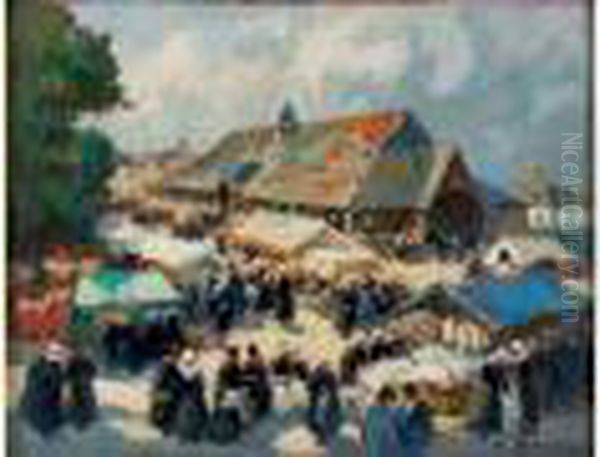
Like many artists before and during his time, Barnoin felt the pull of Brittany. This region, with its dramatic coastline, distinctive traditions, vibrant local costumes, and, crucially, its unique quality of light, offered a powerful antidote to the urban environment of Paris. Artists sought authenticity and picturesque subjects, and Brittany provided these in abundance. Following his studies, likely around 1919 after a period of exhibiting, Barnoin made the decisive move to Concarneau, a bustling fishing port famous for its walled old town (Ville Close) and lively maritime activity.
In Concarneau, Barnoin didn't just visit; he immersed himself. He established a studio strategically located near the harbour, the very heart of the town's life and the source of his primary inspiration. This proximity allowed him constant access to the ebb and flow of fishing boats, the daily routines of fishermen and their families, and the colourful chaos of the quayside markets. Concarneau became not just his home but the central motif of his artistic output for the remainder of his life.
Artistic Style: Bridging Tradition and Modernity
Henri Barnoin's style is often characterized as a pleasing synthesis of academic tradition and a more modern, light-infused approach, sometimes loosely associated with Post-Impressionism or the specific regional schools of Brittany. His grounding at the École des Beaux-Arts is apparent in the solid drawing and well-structured compositions that underpin his paintings. Figures are clearly delineated, and scenes are arranged with a careful eye for balance and narrative clarity.
However, Barnoin moved beyond strict academicism by embracing the brighter palette and more expressive brushwork that had revolutionized French painting in the preceding decades. He was particularly adept at capturing the distinctive luminosity of the Breton coast – the interplay of sunlight on water, the reflections in the harbour, the bright colours of sails and market stalls under the open sky. His paintings often possess a vibrant energy, conveyed through lively colour choices and a confident application of paint, capturing atmosphere and fleeting moments rather than just static representation. While not an Impressionist in the strictest sense, his attention to light effects owes a debt to their innovations.
His work is often noted for its "modernity" within the context of Breton painting. This refers not necessarily to avant-garde experimentation but to his ability to depict traditional scenes – fishing activities, market days, religious processions ('Pardons') – with a freshness and vitality that felt contemporary. He successfully translated the enduring character of Breton life into a visual language that was accessible and appealing to audiences of his time.
The Concarneau Group and Artistic Milieu
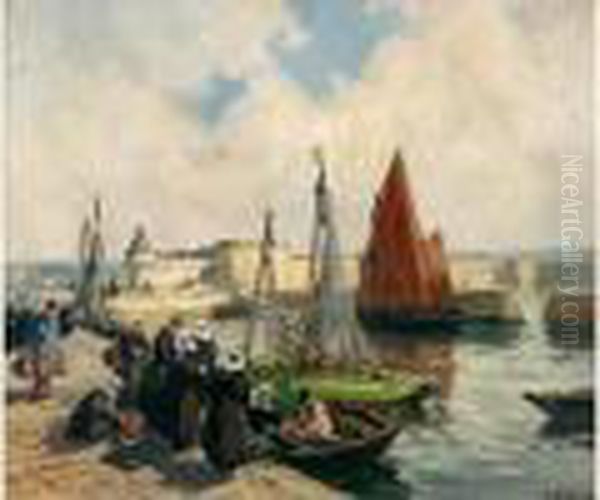
Upon settling in Concarneau, Barnoin quickly became part of the local artistic community. The town, like nearby Pont-Aven, had attracted artists for decades. Barnoin joined or became closely associated with the artists working there, sometimes referred to collectively, albeit informally, as the "Group of Concarneau" or "Les Artistes de Concarneau." This network provided camaraderie, mutual support, and likely a degree of artistic exchange.
Among his contemporaries in Concarneau, Barnoin formed a notable friendship with Arthur Midy (1877-1944), another painter who specialized in Breton scenes and shared Barnoin's fascination with the region's life and light. While specific collaborative projects between Barnoin and Midy, or other members of the Concarneau group, are not well-documented in the provided sources, the shared environment and subject matter inevitably led to interaction and likely some cross-pollination of ideas or techniques. Living and working in close proximity, these artists observed the same scenes, frequented the same locations, and responded to the same unique atmosphere.
The artistic environment in Brittany during Barnoin's time was rich and varied. The legacy of the Pont-Aven School, led by Paul Gauguin and Émile Bernard decades earlier, still lingered, having established Brittany as a place of artistic pilgrimage. Barnoin worked in a later period but benefited from this established reputation. Other notable artists drawn to Brittany's coasts and interiors around this time included Lucien Simon and Charles Cottet (members of the 'Bande Noire', known for their more somber palettes but also depicting Breton life), the Post-Impressionist Maxime Maufra, and Henry Moret, who, like Barnoin, focused on coastal light. Even earlier figures like Eugène Boudin had painted the Breton shores, and Impressionists like Claude Monet captured the wild beauty of Belle-Île. This broader context highlights the magnetic appeal of Brittany for diverse artistic temperaments.
Key Themes and Beloved Subjects
Henri Barnoin's oeuvre is dominated by his depictions of Brittany, particularly the coastal region around Concarneau and nearby towns like Le Faouët. His most recurrent and celebrated themes include:
Harbour Scenes: Concarneau's harbour was his primary muse. He painted it from countless angles and at different times of day, capturing the forest of masts belonging to the tuna and sardine fishing boats (thoniers and sardiniers), the reflections of hulls in the water, and the activity along the quays. Works titled Harbour Scene or Port de Concarneau are numerous.
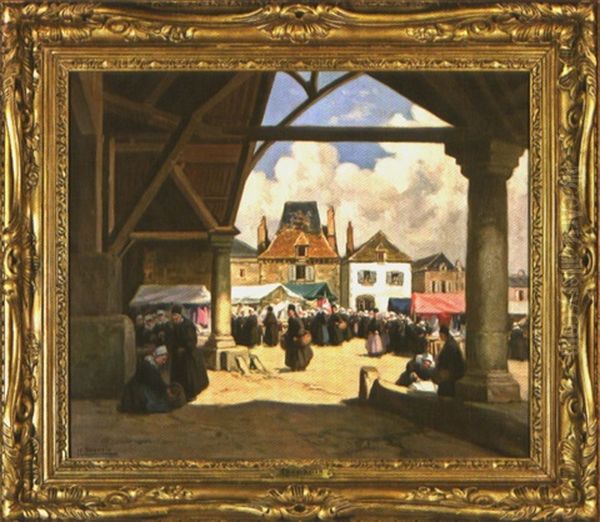
Market Days: Markets were another favourite subject, offering a riot of colour, activity, and social interaction. He depicted the bustling crowds, the vendors selling fish, produce, or traditional cloth, often set against the backdrop of town architecture. Marché à Concarneau, Marché aux Toiles au Faouet, Marché aux fruits au Faouët, and Vue de Marché exemplify this theme. He was known to be a regular visitor to the market at Le Faouët, gathering inspiration.
Return from Fishing: The dramatic or quotidian return of the fishing fleet was a subject rich with narrative potential, depicting the hard labour and communal reliance on the sea. Le Retour de la Pêche (or Le retour des pêcheurs) captures this essential aspect of Breton coastal life.
Pardon Ceremonies: Barnoin also recorded the deeply ingrained religious traditions of Brittany, particularly the 'Pardons' – annual religious festivals and processions where locals donned traditional costumes. Paintings like Soir de Pardon (Evening Pardon Ceremony) and prints like Jour de pardon à Notre-Dame de la Joie document these culturally significant events, often imbued with a sense of solemnity and community spirit.
Local Life and Figures: Underlying all these themes was an interest in the people of Brittany – the fishermen in their distinctive attire, the women in their starched white coiffes (headdresses), the market traders, and the townspeople going about their daily lives. He portrayed them with sympathy and a keen eye for characteristic detail.
While Brittany dominated, Barnoin occasionally painted other locations, including views along the Seine in Paris, such as Quai de la Seine - Vue de l'Ile Saint-Louis, demonstrating his versatility beyond his adopted region. He also produced works listed simply as Portrait or Model, suggesting occasional forays into other genres, and even pastoral scenes like Shepherd by the River.
Notable Works: A Visual Record
Identifying a definitive list of "most important" works can be challenging, but several paintings and prints consistently appear in records and represent key aspects of his output. Based on the provided information and common attributions, notable examples include:
Harbour Scene, Concarneau: A quintessential Barnoin subject, likely existing in multiple variations, capturing the vibrant life of the port.
Marché à Concarneau (Market Day in Concarneau): A lively depiction of the town's market, often featuring figures in traditional dress (e.g., the 38 x 46 cm version).
Le Retour de la Pêche (Return from Fishing): Capturing the essence of the maritime community's reliance on the sea (e.g., the 38 x 46 cm version and possibly the larger 60 x 73 cm Le retour des pêcheurs).
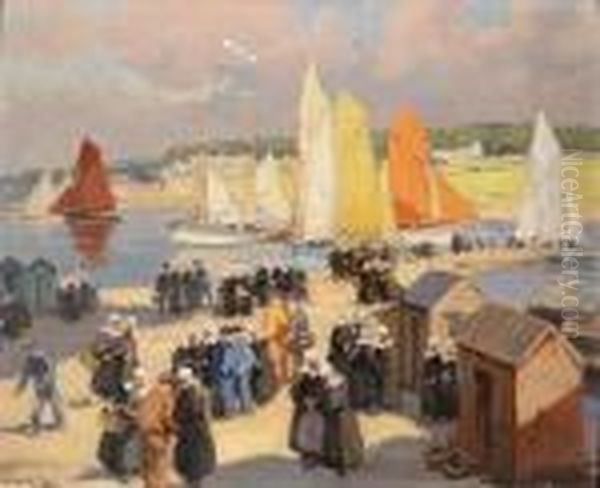
Soir de Pardon (Evening Pardon Ceremony, 1933): Representing his interest in Brittany's unique religious traditions and festivals. A version titled Bretagne, Soir de Pardon is noted in the Musée de Locronan.
Marché aux Toiles au Faouet (Cloth Market at Faouet): Demonstrating his interest in specific market types and locations beyond Concarneau (e.g., the 38 x 46 cm version).
Cotriade au port de Concarneau (Gathering/Fish Stew Meal at the Port of Concarneau): A scene depicting social life and camaraderie among the fishing community (e.g., the 60 x 73 cm version).
Vue de Marché (Market View): A more general title possibly covering various market scenes (e.g., the 44.5 x 55.5 cm version).
Marché devant la Tour Carrée de Saint-Guenolé (Market in front of the Square Tower of Saint-Guenolé): A specific topographical scene, noted as a polychrome print (36 x 48 cm), indicating his work in printmaking.
Jour de pardon à Notre-Dame de la Joie (Pardon Day at Our Lady of Joy): Another print depicting a religious festival (20 x 27 cm).
Concarneau la Ville Close (Concarneau the Walled Town): Focusing on the iconic architecture of the old town (e.g., the 36 x 48 cm version).
These titles, often descriptive and tied to specific locations or activities, underscore Barnoin's role as a visual chronicler of his adopted Breton home. The recurring dimensions (e.g., 38x46 cm) suggest he may have worked in standard formats, perhaps for ease of sale or exhibition.
Exhibitions, Recognition, and Collections
Henri Barnoin achieved considerable recognition during his lifetime, exhibiting regularly and garnering prestigious awards. His participation in the Paris Salon, the official, influential art exhibition of the Académie des Beaux-Arts, was a significant marker of success. He was awarded a Silver Medal at the Salon in 1921 and, later, a Gold Medal in 1935. These accolades cemented his reputation within the French art establishment.
His work was featured in various exhibitions, including one titled "Feu d'artifice," which showcased several of his Breton scenes. Beyond the Salons, his paintings found their way into public and private collections. Notably, museums dedicated to preserving the art and culture of Brittany acquired his work. The Musée de Locronan holds his Bretagne, Soir de Pardon, and the Musée du Faouët, which specializes in art related to Brittany, holds several pieces, including market and port scenes.
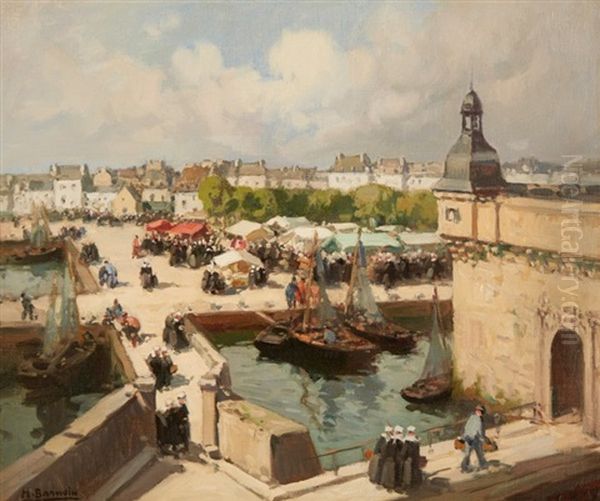
Barnoin's paintings also proved popular with collectors, both French and international. His works continue to appear regularly at auction houses, such as Drouot Richelieu in Paris and regional auctioneers like Quimper Enchères. Auction records provide valuable information on his market presence and the types of works available, ranging from finished oils to prints. Price estimates, like the €2000-€3000 mentioned for a Harbour Scene, indicate a steady, if not astronomical, market appreciation for his work, reflecting his status as a well-regarded regional painter. His inclusion in publications like TABLEAUX MODERNES - ECOLES BRETONES and even reports like COMMISSaires-PRESTS ILLUMINANTS further attests to his visibility.
Legacy and Evaluation: Capturing a Moment in Time
Henri Alphonse Barnoin's legacy lies primarily in his affectionate and skillful portrayal of Brittany, particularly Concarneau, during the early decades of the twentieth century. He was not a revolutionary figure pushing the boundaries of modernism like Gauguin or the later Surrealists. Instead, he excelled as an observer and interpreter of a specific place and its enduring traditions, rendered in a style that balanced academic solidity with the vibrant light and colour associated with Post-Impressionist sensibilities.
His contribution is significant within the context of Breton regional art. He stands among the many talented painters who found inspiration in Brittany's unique character, but his long-term residency in Concarneau and his focus on its daily life give his work a particular authenticity and depth. He captured a world centred on the sea – the labour of fishing, the commerce of the markets, the communal bonds expressed in festivals – with both accuracy and atmospheric charm.
His paintings serve as valuable visual documents of Breton life before widespread industrialization and cultural homogenization took hold. The traditional costumes, the sailing fishing vessels, the bustling quayside scenes – these were elements of a distinct regional identity that Barnoin helped to preserve in his art. His ability to infuse these scenes with light and colour ensures they remain visually appealing and evocative today. While perhaps overshadowed on the international stage by more famous names associated with Brittany like Gauguin or Monet, Barnoin holds a secure and respected place as a chronicler of Concarneau's golden age as an artists' haven and a vibrant fishing port. He died in Paris in 1940, leaving behind a substantial body of work celebrating the enduring allure of the Breton coast.